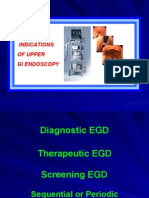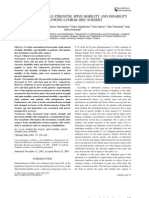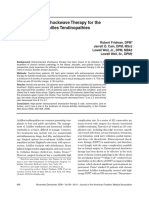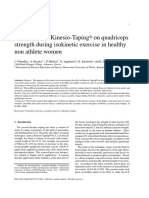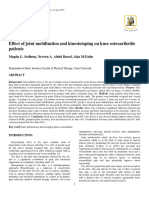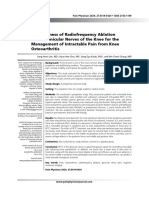Comparison of Effectiveness of Ultrasoun
Comparison of Effectiveness of Ultrasoun
Uploaded by
kevenwrodriCopyright:
Available Formats
Comparison of Effectiveness of Ultrasoun
Comparison of Effectiveness of Ultrasoun
Uploaded by
kevenwrodriOriginal Title
Copyright
Available Formats
Share this document
Did you find this document useful?
Is this content inappropriate?
Copyright:
Available Formats
Comparison of Effectiveness of Ultrasoun
Comparison of Effectiveness of Ultrasoun
Uploaded by
kevenwrodriCopyright:
Available Formats
International Journal of Health Sciences and Research
www.ijhsr.org ISSN: 2249-9571
Original Research Article
Comparison of Effectiveness of Ultrasound plus
Strengthening Exercises and Transcutaneous
Electric Nerve Stimulation in Managing Functional
Activity and Pain in Patients with Acute Knee
Osteoarthritis
Monica Preet Kour1, Shyamal Koley2
1
Post-Graduate Student, 2Professor and Head,
Department of Physiotherapy, Guru Nanak Dev University, Amritsar - 143005, Punjab, India
Corresponding Author: Shyamal Koley
ABSTRACT
Introduction: In elderly population, osteoarthritis is very common, affecting mostly knees, hands,
hips, spine, and feet. Knee osteoarthritis can be commonly classified into acute or chronic stage. In
the present study, four weeks interventions with ultrasound plus strengthening exercises and
transcutaneous electric nerve stimulation were given to patients with acute knee osteoarthritis to
observe the efficacy of these modalities.
Method: A total of purposively selected 50 confirmed cases of acute knee osteoarthritis aged 31-65
years were considered for the present study and were collected from the Government Medical
College, Jammu, Jammu & Kashmir, India. The subjects were divided into two groups for
intervention. Group A consisted of 25 subjects who were treated with ultrasound plus strengthening
exercises for four weeks. Group B consisted of 25 subjects who were treated with transcutaneous
electric nerve stimulation (TENS) for 4 weeks.
Results: Statistically significant differences (p<0.022-0.002) were found in functional activity score
(before and after treatment) and pain (after treatment) between the two sets of data. When male and
female acute knee osteoarthritis patients treated with ultrasound plus strengthening exercises were
compared, statistically no significant differences (p>0.05) were found in any case between them.
Similarly, when male and female acute knee osteoarthritis patients treated with TENS were compared,
statistically significant differences (p<0.035-0.017) were found in weight and BMI only between
them.
Conclusion: It might be concluded that ultrasound plus strengthening exercises were more effective
than transcutaneous electric nerve stimulation for increment of functional activity and reduction of
pain in patients with acute knee osteoarthritis.
Key Words: Acute knee osteoarthritis patient. Ultrasound plus strengthening exercises.
Transcutaneous electric nerve stimulation.
INTRODUCTION radiographic evidence of Osteoarthritis is
Osteoarthritis (OA) is one of the approximately 85%, [3] affecting mostly
most common musculoskeletal disorders knees, hands, hips, spine, and feet. [4-6]
resulting in chronic degenerative joint Patients with knee OA present mostly with
disease. [1,2] In elderly population pain, articular stiffness, crepitation, articular
International Journal of Health Sciences & Research (www.ijhsr.org) 129
Vol.9; Issue: 5; May 2019
Monica Preet Kour et.al. Comparison of Effectiveness of Ultrasound plus Strengthening Exercises and
Transcutaneous Electric Nerve Stimulation in Managing Functional Activity and Pain in Patients with Acute
Knee Osteoarthritis
edema, joint deformities, articular plus strengthening exercises and
instability, decrease in range of motion transcutaneous electric nerve stimulation in
(ROM), physical activity limitations and patients with acute knee osteoarthritis.
muscle weakness. [6,7] Hence pain relief with
pharmacologic [8,9] and non-pharmacologic MATERIALS AND METHODS
strategies [10-13] have been studied widely. Subjects
Knee joint being major weight The present cross-sectional study
bearing joint consists of: Tibiofemoral joint was based on purposively selected 50
and Patellofemoral joint. Osteoarthritis is a confirmed cases of acute knee osteoarthritis
chronic degenerative disorder primarily aged 31-65 years. The samples were
affecting the articular cartilage of synovial collected from the Government Medical
joint, with eventual bony remodelling and College, Jammu, Jammu & Kashmir, India.
overgrowth at margins of the joints. [14] The subjects were divided into two groups
Knee Osteoarthritis can be commonly for intervention. Group A consisted of 25
classified into acute or chronic stage. Some subjects (21 females and 04 males) who
peculiar features of Knee Osteoarthritis are were treated with ultrasound plus
– pain initially on weight bearing later strengthening exercises for four weeks.
becomes continuous even at rest, swollen Group B consisted of 25 subjects (21
joints due to synovitis, stiffness sets in females and 04 males) who were treated
which gradually results in deformity. [15] with transcutaneous electric nerve
Signs and symptoms of end stage OA stimulation for 4 weeks. The study was
include- severe pain, loss of joint motion approved by the Institutional Ethics
and movements of involved joints, joint Committee.
effusion, and abnormal gait mechanics. [16] Anthropometric Measurements
Osteoarthritis is steadily becoming the most Three anthropometric variables, such
common cause for middle age and for those as, height, weight and BMI were taken on
above the age of 65 years. [17] each subject using the techniques provided
Physiotherapy provides very by Lohman et al. [23] and were measured in
effective non-pharmacological interventions triplicate with the median value used as the
knee osteoarthritis [18] and procedures criterion.
prescribed by physiotherapists are The height was recorded during
considered important and play a inspiration using a stadiometer (Holtain
fundamental role in patients’ treatment. In Ltd., Crymych, Dyfed, UK) to the nearest
this context, kinesiotherapy (KIN) 0.1 cm. Weight was measured by digital
comprising of different types of therapeutic standing scales (Model DS-410, Seiko,
exercises, such as stretching, strengthening Tokyo, Japan) to the nearest 0.1 kg. BMI
(isotonic, isokinetic, and isometric) and was then calculated using the formula
aerobic exercise, [19] and electrotherapy are weight (kg)/height 2 (m) 2. Functional
frequently used for the treatment of different activity and pain score of the patients were
[20-22]
musculoskeletal disorders. measured by Samual-Greenguard
Electrotherapy includes ultrasound (US), a Questionnaire (SGQ) and Visual Analog
modality of treatment that uses sound waves Scale (VAS).
to generate heat within a body part, and Ultrasound with Knee Strengthening
transcutaneous electrical nerve stimulation Exercises
(TENS), a method of pain relief in which a In this group, patients of acute knee
special device transmits low-voltage osteoarthritis were treated with ultrasound
electrical impulses through electrodes on the along with knee strengthening exercises for
skin to an area of the body that is in pain. [8] four weeks. Session started with patients of
In the present study an attempt has been this group to perform the exercises, such as,
made to observe the efficacy of ultrasound Isometric Quadriceps Exercise, Patellar
International Journal of Health Sciences & Research (www.ijhsr.org) 130
Vol.9; Issue: 5; May 2019
Monica Preet Kour et.al. Comparison of Effectiveness of Ultrasound plus Strengthening Exercises and
Transcutaneous Electric Nerve Stimulation in Managing Functional Activity and Pain in Patients with Acute
Knee Osteoarthritis
Mobility Exercise, End Range Extension undergoing treatment was slightly flexed
and Active Knee Flexion-extension. One set and supported with pillow. The area of the
consisted of 10 repetitions; one repetition skin was cleansed with alcohol to improve
was held for 10 seconds followed by 10 skin conductivity. Four rubber electrodes
seconds rest between each successive with acoustic gel spreaded evenly over them
repetition and the rest period of 2 minutes to improve conductivity were applied to
between the 2 successive sets. Patients were either side of the affected knee joint aligned
asked to perform 2 sets per session per day. longitudinally along the length of the limb.
After the completion of exercises, patients The electrodes were secured using Velcro
were given continuous Ultrasound therapy straps. Stimulation frequency was 80 Hz
with 1.5 Watt/cm2 for 10 minutes with continuous, phase duration was 200 ms, and
frequency of 1 MHz. For this, subjects were the current intensity will be strong but
made to sit with knee partially flexed with a comfortable. Each TENS treatment session
pillow underneath the knee. Acoustic gel lasted 30 minutes. The patients of this group
was applied to the treatment head as well as were treated in the same way 5 times /week
to the skin over the knee joint to allow for 4 weeks.
perfect contact and allow maximum Statistical Analysis
transmission of the sonic waves. The Standard descriptive statistics (mean
patients of this group were treated in the ± standard deviation) were determined for
similar manner for 5 sessions/week for 4 directly measured and derived variables.
weeks. Student’s t-test was used for the comparison
Transcutaneous Electric Nerve of various variables between patients treated
Stimulation (TENS) with ultrasound plus strengthening exercises
In this group, patients were treated and TENS. Data were analyzed using SPSS
with transcutaneous electric nerve (Statistical Package for Social Science)
stimulation for 4 weeks. Patients of this version 20.0. A 5% level of probability was
group were positioned for treatment lying used to indicate statistical significance.
supine on the treatment bed. Knee
RESULTS
Table 1: Descriptive statistics of selected variables in acute knee osteoarthritis patients treated with ultrasound plus strengthening
exercises and TENS
Variables PUS+SE (n =25 ) PTENS (n =25 ) t-value p-value
Mean SD Mean SD
Age (years) 50.76 6.41 49.24 4.94 0.964 0.340
HT (cm) 160.20 6.19 158.56 5,52 1.013 0.326
WT (kg) 61.64 12.66 62.00 7.05 0.124 0.902
BMI (kg/m2) 24.02 4,81 24.78 3.52 0.631 0.531
SMQBT (%) 44.36 6.53 39.08 5.07 3.192 <0.002
SMQAT (%) 41.20 6.18 37.40 5.14 2.364 <0.022
VASBT 7.16 1,28 6.84 0.85 1.041 0.303
VASAT 4.68 1.60 5.84 0.94 3.123 <0.003
PUS+SE = patients with ultrasound plus strengthening exercises, PTENS = patients with TENS, HT = height, WT = weight, BMI = b ody
mass index, SMQBT = Samual-Greenguard Questionnaire score before treatment, SMQAT = Samual-Greenguard Questionnaire score after
treatment, VASBT = Visual Analog Scale before treatment, VASAT = Visual Analog Scale after treatment.
Table 2: Descriptive statistics of selected variables in male and female acute knee osteoarthritis patients treated with ultrasound
plus strengthening exercises
Variables Female patients (n =21 ) Male patients (n =04 ) t-value p-value
Mean SD Mean SD
Age (years) 50.43 6.93 52.50 1.73 0.584 0.565
HT (cm) 160.52 6.39 158.50 4.45 0.591 0.560
WT (kg) 61.00 12.83 65.00 12.91 0.571 0.574
BMI (kg/m2) 23.67 4.81 25.87 5.09 0.832 0.414
SMQBT (%) 44.86 6.47 41.75 7.13 0.868 0.395
SMQAT (%) 41,28 6.67 40.75 2.87 0.156 0.878
VASBT 7.28 1.27 6.50 1.29 1.131 0.270
VASAT 4.76 1.64 4.25 1.50 0.578 0.569
International Journal of Health Sciences & Research (www.ijhsr.org) 131
Vol.9; Issue: 5; May 2019
Monica Preet Kour et.al. Comparison of Effectiveness of Ultrasound plus Strengthening Exercises and
Transcutaneous Electric Nerve Stimulation in Managing Functional Activity and Pain in Patients with Acute
Knee Osteoarthritis
Table 1 showed the descriptive statistics of selected variables in acute knee osteoarthritis
patients treated with ultrasound plus strengthening exercises and TENS. Statistically
significant differences (p<0.022-0.002) were found in SMQ score (before and after treatment)
and VAS (after treatment) between the two sets of data.
Table 3: Descriptive statistics of selected variables in male and female acute knee osteoarthritis patients treated wit h TENS
Variables Female patients (n =21 ) Male patients (n =04 ) t-value p-value
Mean SD Mean SD
Age (years) 48.95 4.25 50.75 6,70 0.710 0.485
HT (cm) 158.76 5.37 157.50 4.93 0.436 0.667
WT (kg) 60.57 6.17 69.50 7.37 2.582 <0.017
BMI (kg/m2) 24.14 3.18 28.12 3.74 2.240 <0.035
SMQBT (%) 38.90 5.17 40.00 5.10 0.389 0.701
SMQAT (%) 37.28 5.26 38.00 5.10 0.250 0.805
VASBT 6.86 0.91 6.75 0.50 0.226 0.823
VASAT 5.86 1.01 5.75 0.50 0.204 0.840
The descriptive statistics of selected 7.12%, whereas, using transcutaneous
variables in male and female acute knee electric nerve stimulation, the increment
osteoarthritis patients treated with was 4.30%. So far decrement of pain was
ultrasound plus strengthening exercises concerned, patients treated with ultrasound
were shown in table 2. Statistically no plus strengthening exercises had the value
significant differences (p>0.05) were found of 34.64% and with transcutaneous electric
in any case between them. nerve stimulation, the decrement was
Table 3 showed the descriptive statistics of 14.62%. Thus, it might be concluded that
selected variables in male and female acute ultrasound plus strengthening exercises
knee osteoarthritis patients treated with were more effective than transcutaneous
TENS. Statistically significant differences electric nerve stimulation for increment of
(p<0.035-0.017) were found in weight and functional activity and reduction of pain in
BMI between the two sets of data. patients with acute knee osteoarthritis. As it
is known that ultrasound is a modality of
DISCUSSION treatment that uses sound waves to generate
Osteoarthritis is widely believed to heat within a body part [8] and knee
result from local mechanical factors acting strengthening exercises program aims to
within the context of systemic susceptibility. reduce the medial knee load and pain and
[24]
For clinicians, researchers and improve function in people with medial
policymakers, it is important to be able to compartment osteoarthritis. [25] Rutjes et al.
[26]
determine the most successful treatment failed to confirm that transcutaneous
protocol for managing functional activity electric nerve stimulation was effective for
and pain in patients with acute knee pain relief in patients with acute knee
osteoarthritis. In the present study, four osteoarthritis. The findings of the present
weeks interventions with ultrasound plus study followed the same direction. The
strengthening exercises were given to 25 limitation of the study was small sample
patients and transcutaneous electric nerve size, especially in male patients. For this
stimulation for four weeks were given to reason, when the comparison of functional
another 25 patients. Statistically significant activity and pain between male and female
differences were found between the two sets patients were done, no significant
of population in functional activity (before differences were found (except in two
and after treatment) and pain (after cases). More extensive studies are required
treatment) (table 1). The findings of the considering greater sample size to validate
present study showed that patients treated the data.
with ultrasound plus strengthening exercises
had increased their functional activity with
International Journal of Health Sciences & Research (www.ijhsr.org) 132
Vol.9; Issue: 5; May 2019
Monica Preet Kour et.al. Comparison of Effectiveness of Ultrasound plus Strengthening Exercises and
Transcutaneous Electric Nerve Stimulation in Managing Functional Activity and Pain in Patients with Acute
Knee Osteoarthritis
CONCLUSION treatment of knee osteoarthritis. Expert Opin
From the findings of the present Pharmacother 2008; 9(10): 1797–1804.
study, it might be concluded that ultrasound 10. Hawker GA, Mian S, Bednis K, Stanaitis I.
plus strengthening exercises were more Osteoarthritis year 2010 in review: non
pharmacologic therapy. Osteoarthr Cartil.
effective than transcutaneous electric nerve
2011; 19(4):366–374.
stimulation for increment of functional 11. Suarez-Almazor ME, Looney C, Liu Y, Cox
activity and reduction of pain in patients V, Pietz K, Marcus DM, Street RL Jr. A
with acute knee osteoarthritis. randomized controlled trial of acupuncture
for osteoarthritis of the knee: effects of
REFERENCES patient-provider communication. Arthritis
1. Bennell KL, Egerton T, Wrigley TV, Care Res (Hoboken) 2010; 62(9): 1229–
Hodges PW, Hunt M, Roos EM, Kyriakides 1236.
M, Metcalf B, Forbes A, Ageberg E, 12. Myers SS, Phillips RS, Davis RB, Cherkin
Hinman RS. Comparison of neuromuscular DC, Legedza A, Kaptchuk TJ. Patient
and quadriceps strengthening exercise in the expectations as predictors of outcome in
treatment of varus malaligned knees with patients with acute low back pain. J Gen
medial knee osteoarthritis: a randomised Intern Med 2008; 23(2): 148–153.
controlled trial protocol. BMC 13. Linde K, Witt CM, Streng A,
Musculoskelet Disord 2011;12: 276. Weidenhammer W, Wagenpfeil S,
2. Hunter DJ, Sharma L, Skaife T. Alignment Brinkhaus B, Willich SN, Melchart D. The
and osteoarthritis of the knee. J Bone Joint impact of patient expectations on outcomes
Surg Am 2009;1: 85–89. in four randomized controlled trials of
3. Cooper C. In: Rheumatology. Klippel J, acupuncture in patients with chronic
Dieppe P, editor. CV Mosby, New York. pain. Pain 2007; 128(3): 264–271.
The Epidemiology of Osteoarthritis 1994; p. 14. Kisner C, Colby LA. Therapeutic Exercise:
7.3.1-4. Foundation and Techniques. Philadelphia,
4. Osiri M, Welch V, Brosseau L, Shea B, Pa: FA Davis Co1985; 302.
McGowan J, Tugwell P, Wells G. 15. Joshi J. Essentials of Orthopedics and
Transcutaneous electrical nerve stimulation applied Physiotherapy. 1999; 294.
for knee osteoarthritis. Cochrane Database 16. Nicholas J, Heshman E. Osteoarthrosis of
Syst Rev 2000; 4:CD002823. the knee. In Distefano VJ, editor. The lower
5. Rutjes AW, Nüesch E, Sterchi R, extremity & spine in sports medicine. St
Kalichman L, Hendriks E, Osiri M, Louis (MO) C.V. Mosby 1986; pp. 881-890.
Brosseau L, Reichenbach S, Jüni P. 17. Buckwalter J, Martin J, Mankin H. Synovial
Transcutaneous electrostimulation for joint degeneration and syndrome of
osteoarthritis of the knee. Cochrane osteoarthritis Instr Course Lect 2000; 49:
Database Syst Rev 2009; 4:CD002823. 481-489.
6. Leslie M. Knee osteoarthritis management 18. Deyle GD, Allison SC, Matekel RL, Ryder
therapies. Pain Manag Nurs 2000; 1(2): 51– MG, Stang JM, Gohdes DD, Hutton JP,
57. Henderson NE, Garber MB. Physical
7. Bennell KL, Hinman RS, Metcalf BR, therapy treatment for osteoarthritis of the
Buchbinder R, McConnell J, McColl G, knee: a randomised comparison of
Green S, Crossley KM. Efficacy of supervised clinical exercise and manual
physiotherapy management of knee joint therapy procedures versus a home exercise
osteoarthritis: a randomised, double blind, programme. Phys Ther 2005; 85(12): 1301–
placebo controlled trial. Ann Rheum 1317.
Dis 2005; 64(6): 906–912. 19. Bunning RD, Materson RS. A rational
8. Altman RD. Pharmacological therapies for program of exercise for patients with
osteoarthritis of the hand: A review of the osteoarthritis. Semin Arthritis Rheum 1991;
evidence. Drugs Aging 2010; 27(9): 729– 21(3) :33–43.
745. 20. Rutjes AW, Nüesch E, Sterchi R, Jüni P.
9. Conrozier T, Chevalier X. Long-term Therapeutic ultrasound for osteoarthritis of
experience with hylan GF-20 in the the knee or hip. Cochrane Database Syst
Rev 2010; 1:CD003132.
International Journal of Health Sciences & Research (www.ijhsr.org) 133
Vol.9; Issue: 5; May 2019
Monica Preet Kour et.al. Comparison of Effectiveness of Ultrasound plus Strengthening Exercises and
Transcutaneous Electric Nerve Stimulation in Managing Functional Activity and Pain in Patients with Acute
Knee Osteoarthritis
21. Kozanoglu E, Basaran S, Guzel R, Guler- 25. Bennell KL, Egerton T, Tim VW, Paul WH,
Uysal F. Short term efficacy of ibuprofen Michael H, Ewa MR, Mary K, Ben M,
phonophoresis versus continuous ultrasound Andrew F, Eva A, Rana SH. Comparison of
therapy in knee osteoarthritis. Swiss Med neuromuscular and Quadriceps
Wkly 2003; 133(23–24) : 333–338. strengthening exercise in the treatment of
22. Sharma L. Non-pharmacologic management varus malaligned knees with medial knee
of osteoarthritis. Curr Opin Rheumatol. osteoarthritis: A randomised controlled trial
2002; 14(5): 603–607. protocol. BMC Musculoskeletal Disorders
23. Lohmann TG, Roche AF, Martorell R 2011; 12: 276-287.
Anthropometric Standardization Reference 26. Rutjes AWS, Nuesch E, Sterchi R,
Manual. Champaign, IL: Human Kinetics Kalichman L, Hendriks E, Osiri M,
Books 1988. Brosseau L, Reichenbach S, Juni P.
24. Sharma L, Song J, Felson DT, Cahue S, Transcutaneous electro stimulation for
Shamiyeh E, Dunlop DD. The role of knee osteoarthritis of the knee (Review).
alignment in disease progression and Cochrane Database of Systematic Reviews
fundamental decline in knee osteoarthritia. 2009; 4: Art No. CD002823.
JAMA 2001; 286: 188-295.
How to cite this article: Kour MP, Koley S. Comparison of effectiveness of ultrasound plus
strengthening exercises and transcutaneous electric nerve stimulation in managing functional
activity and pain in patients with acute knee osteoarthritis. Int J Health Sci Res. 2019; 9(5):129-
134.
******
International Journal of Health Sciences & Research (www.ijhsr.org) 134
Vol.9; Issue: 5; May 2019
You might also like
- Active Release TechniquesDocument15 pagesActive Release TechniquesPhysiotherapist Ali50% (2)
- Medicine History and CounsellingDocument13 pagesMedicine History and Counsellingpranjl100% (1)
- Indications of Upper GI EndosDocument25 pagesIndications of Upper GI EndosDrTanta100% (3)
- Selectividad Abuseofantibiotics - June2001Document3 pagesSelectividad Abuseofantibiotics - June2001Penny RivasNo ratings yet
- MPU3242 IMjuly19Project BBMS L03F MiniaturePortableArtificalKidney Luqman 0133133922Document36 pagesMPU3242 IMjuly19Project BBMS L03F MiniaturePortableArtificalKidney Luqman 0133133922Hema KuganNo ratings yet
- Research Article: Effects of Low-Level Laser Therapy and Eccentric Exercises in The Treatment of Patellar TendinopathyDocument7 pagesResearch Article: Effects of Low-Level Laser Therapy and Eccentric Exercises in The Treatment of Patellar TendinopathyAlvin JulianNo ratings yet
- Progressive Strengthening and Stretching Exercises and Ultrasound For Chronic Lateral EpicondylitisDocument9 pagesProgressive Strengthening and Stretching Exercises and Ultrasound For Chronic Lateral EpicondylitisTomBrambo100% (1)
- DeepDocument5 pagesDeepzihanw385No ratings yet
- International Journal of Health Sciences and ResearchDocument7 pagesInternational Journal of Health Sciences and ResearchMuhamad BenyaminNo ratings yet
- E F T S E - M D: AP S: Ffect of Lexibility Raining On Ymptoms OF Xercise Induced Uscle Amage Reliminary TudyDocument7 pagesE F T S E - M D: AP S: Ffect of Lexibility Raining On Ymptoms OF Xercise Induced Uscle Amage Reliminary TudySudhakar SubramanianNo ratings yet
- Posterior Tibialis Tendonitis StudyDocument6 pagesPosterior Tibialis Tendonitis StudyShane WetzelNo ratings yet
- Effectiveness of Eccentric Exercise in Tennis Elbow - A Single CaseDocument2 pagesEffectiveness of Eccentric Exercise in Tennis Elbow - A Single Caseirfan setiadiNo ratings yet
- 0Document11 pages0kang soon cheolNo ratings yet
- Pemeriksaan StrainDocument8 pagesPemeriksaan StrainTRI NANDA SILVIANINo ratings yet
- 11 (2) Effectiveness of Therapeutic Ultrasound and Kinesiotape in Treatment of Tennis Elbow (Jusmaniar) IIDocument9 pages11 (2) Effectiveness of Therapeutic Ultrasound and Kinesiotape in Treatment of Tennis Elbow (Jusmaniar) IIainunNo ratings yet
- Filippi G.M.Document5 pagesFilippi G.M.berardinoNo ratings yet
- ptrs009 03 03 PDFDocument6 pagesptrs009 03 03 PDFGusti Ayu KrisnayantiNo ratings yet
- Effects of Kinesiotherapy, Ultrasound and Electrotherapy in Management of Bilateral Knee Osteoarthritis: Prospective Clinical TrialDocument10 pagesEffects of Kinesiotherapy, Ultrasound and Electrotherapy in Management of Bilateral Knee Osteoarthritis: Prospective Clinical TrialDavid Alejandro Cavieres AcuñaNo ratings yet
- Francis 2020 AchillesDocument10 pagesFrancis 2020 AchillespremtimNo ratings yet
- 001 Papar 1 EESSDocument6 pages001 Papar 1 EESSEmilio BurgosNo ratings yet
- Pain, Trunk Muscle Strength, Spine Mobility and Disability Following Lumbar Disc SurgeryDocument5 pagesPain, Trunk Muscle Strength, Spine Mobility and Disability Following Lumbar Disc Surgerye7choevaNo ratings yet
- HKPJ 39 025Document9 pagesHKPJ 39 025IlhamDikaNo ratings yet
- Efficacy of Retrowalking in Patients With Chronic Knee Osteoarthritis: A Single Group Experimental Pilot StudyDocument9 pagesEfficacy of Retrowalking in Patients With Chronic Knee Osteoarthritis: A Single Group Experimental Pilot StudyDr. Krishna N. SharmaNo ratings yet
- International Journal of Health Sciences and ResearchDocument8 pagesInternational Journal of Health Sciences and Researchrizk86No ratings yet
- Static Progressive Stretching Using A Turnbuckle Orthosis For Elbow Stiffness: A Prospective StudyDocument4 pagesStatic Progressive Stretching Using A Turnbuckle Orthosis For Elbow Stiffness: A Prospective StudygllemoineNo ratings yet
- Physiotherapy: P. Ratan Khuman Lourembam Surbala Priyanka Patel Dhara ChavdaDocument4 pagesPhysiotherapy: P. Ratan Khuman Lourembam Surbala Priyanka Patel Dhara ChavdaSahithya MNo ratings yet
- FRIDMAN - Achilles - Tendinopathies PDFDocument3 pagesFRIDMAN - Achilles - Tendinopathies PDFadalberto torrealbaNo ratings yet
- Effect of Lumbar Stabilization Exercise On Disc Herniation Index, Sacral Angle, and Functional Improvement in Patients With Lumbar Disc HerniationDocument5 pagesEffect of Lumbar Stabilization Exercise On Disc Herniation Index, Sacral Angle, and Functional Improvement in Patients With Lumbar Disc HerniationMuhammad Ridha Al JinaniNo ratings yet
- The Effect of Mechanical Massage On Early Outcome After Total Knee ArthroplastyDocument4 pagesThe Effect of Mechanical Massage On Early Outcome After Total Knee Arthroplasty이용기No ratings yet
- Aaa - THAMARA - Comparing Hot Pack, Short-Wave Diathermy, Ultrasound, and Tens On Isokinetic Strength, Pain and Functional StatusDocument9 pagesAaa - THAMARA - Comparing Hot Pack, Short-Wave Diathermy, Ultrasound, and Tens On Isokinetic Strength, Pain and Functional StatusBruno FellipeNo ratings yet
- Therapeutic Effects of Massage and Electrotherapy On Muscle Tone, Stiffness and Muscle Contraction Following Gastrocnemius Muscle FatigueDocument4 pagesTherapeutic Effects of Massage and Electrotherapy On Muscle Tone, Stiffness and Muscle Contraction Following Gastrocnemius Muscle FatigueAina SarahNo ratings yet
- Lee 2017Document8 pagesLee 2017toaldoNo ratings yet
- Extracorporeal Shock Wave Therapy VersusDocument7 pagesExtracorporeal Shock Wave Therapy VersusGiannis SaramantosNo ratings yet
- Immediate Effects of Neuromuscular Joint Facilitation InterventionDocument4 pagesImmediate Effects of Neuromuscular Joint Facilitation InterventionReagir ReagirNo ratings yet
- 29 - Jpts 2017 341Document4 pages29 - Jpts 2017 341Rafii KhairuddinNo ratings yet
- The Effects of Kinesio-Taping On Quadriceps Strength During Isokinetic Exercise in Healthy Non Athlete WomenDocument6 pagesThe Effects of Kinesio-Taping On Quadriceps Strength During Isokinetic Exercise in Healthy Non Athlete WomenSurya DiatmikaNo ratings yet
- The Effects of Kinesio Taping On Quadriceps Strenth During Isokinetic Exercise in Healthy Non-Athlete WomenDocument6 pagesThe Effects of Kinesio Taping On Quadriceps Strenth During Isokinetic Exercise in Healthy Non-Athlete WomenionNo ratings yet
- Effectiveness of Exercise and Cyriax Physiotherapy in Patients With Tennis Elbow (2012)Document8 pagesEffectiveness of Exercise and Cyriax Physiotherapy in Patients With Tennis Elbow (2012)Sufi Muzahid HussainNo ratings yet
- Annals of Medicine and SurgeryDocument4 pagesAnnals of Medicine and SurgeryRita SilvestreNo ratings yet
- NigerJExpClinBiosci2269-8541437 022221Document6 pagesNigerJExpClinBiosci2269-8541437 022221JouleAlSBNo ratings yet
- Effect of Physiotherapeutic Intervention Using TECARDocument9 pagesEffect of Physiotherapeutic Intervention Using TECARAmazonia clinicaNo ratings yet
- Articulo SerratoDocument6 pagesArticulo SerratoPerla RodriguezNo ratings yet
- Effectiveness of Mulligan's Mobilization Technique Versus Eccentric Exercises On Pain, Hand Grip Strength and Function in Subjects With Lateral EpicondylitisDocument8 pagesEffectiveness of Mulligan's Mobilization Technique Versus Eccentric Exercises On Pain, Hand Grip Strength and Function in Subjects With Lateral EpicondylitisInternational Journal of Innovative Science and Research TechnologyNo ratings yet
- Protocol AchillesTendinosisDocument11 pagesProtocol AchillesTendinosisPhooi Yee LauNo ratings yet
- Plantar PainDocument9 pagesPlantar PainMauricio PinalNo ratings yet
- 2009 Ericsson Et Al-2009-Scandinavian Journal of Medicine & Science in SportsDocument10 pages2009 Ericsson Et Al-2009-Scandinavian Journal of Medicine & Science in SportsLuis MiguelNo ratings yet
- 17 Nor AzlinDocument5 pages17 Nor AzlinWira DharmaNo ratings yet
- 675-Article Text-1214-1-10-20210608Document7 pages675-Article Text-1214-1-10-20210608Rama BayuNo ratings yet
- Tascioglu Et Al 2010 Short Term Effectiveness of Ultrasound Therapy in Knee OsteoarthritisDocument10 pagesTascioglu Et Al 2010 Short Term Effectiveness of Ultrasound Therapy in Knee Osteoarthritiskrishnamunirajulu1028No ratings yet
- PQ Art 50150-10Document5 pagesPQ Art 50150-10Alan ArceNo ratings yet
- Comparação Isot IsomeDocument7 pagesComparação Isot IsomecarlosNo ratings yet
- Cervical StretchingDocument5 pagesCervical StretchingSulthan PhysioNo ratings yet
- 10 Jpts 27 1455Document3 pages10 Jpts 27 1455mustafasacarNo ratings yet
- 3-6 - Isometric Exercise Versus Combined Concentric Eccentric Exercise Training in Patients With Osteoarthritis KneeDocument7 pages3-6 - Isometric Exercise Versus Combined Concentric Eccentric Exercise Training in Patients With Osteoarthritis KneeirmarizkyyNo ratings yet
- Effect of Joint Mobilization and Kinesiotaping On Knee OsteoarthriticDocument8 pagesEffect of Joint Mobilization and Kinesiotaping On Knee OsteoarthriticAml ELsaid HamedNo ratings yet
- Effects of Tendon An Nerve Gliding Exercises and Instructions in Activities of Daily Livin Following Endoscopic Carpal Tunnel ReleaseDocument7 pagesEffects of Tendon An Nerve Gliding Exercises and Instructions in Activities of Daily Livin Following Endoscopic Carpal Tunnel ReleaseYimena JoyNo ratings yet
- Ankle SprainDocument7 pagesAnkle SprainZawirNo ratings yet
- Beda Pir Dan Met Pada FleksibilitasDocument5 pagesBeda Pir Dan Met Pada FleksibilitasPradipta EstuNo ratings yet
- Comparative Effect of US Versus Static Stretching On The Extensibility of Hamstring MusclesDocument4 pagesComparative Effect of US Versus Static Stretching On The Extensibility of Hamstring MusclesAdi WesnawaNo ratings yet
- Genicular Nerves of The Knee ForDocument12 pagesGenicular Nerves of The Knee ForMauricio Lopez MejiaNo ratings yet
- Obesity CuadricepsDocument5 pagesObesity CuadricepsGonzalo Aguayo AlcayagaNo ratings yet
- Rajiv Gandhi University of Health Sciences, Bangalore, KarnatakaDocument13 pagesRajiv Gandhi University of Health Sciences, Bangalore, KarnatakaR HariNo ratings yet
- Principles of Manual Medicine for Sacroiliac Joint Dysfunction: Arthrokinematic Approach-Hakata MethodFrom EverandPrinciples of Manual Medicine for Sacroiliac Joint Dysfunction: Arthrokinematic Approach-Hakata MethodShigehiko KatadaNo ratings yet
- Manual of Vibration Exercise and Vibration TherapyFrom EverandManual of Vibration Exercise and Vibration TherapyJörn RittwegerNo ratings yet
- 2 Cell CountingDocument55 pages2 Cell CountingJanielle Medina FajardoNo ratings yet
- Award LetterDocument1 pageAward Letterapi-271891645No ratings yet
- Module 1 (Lesson 3)Document11 pagesModule 1 (Lesson 3)Jovencio Jr. Milo MilanNo ratings yet
- Assignment On: HepatitisDocument12 pagesAssignment On: HepatitisAbdallah KisswaniNo ratings yet
- What Is Bacteriuria? When Is It Significant?Document6 pagesWhat Is Bacteriuria? When Is It Significant?SAMMYNo ratings yet
- J. DAFTAR PUSTAKADocument6 pagesJ. DAFTAR PUSTAKADewiNo ratings yet
- BPT II Year TRDocument32 pagesBPT II Year TRHarshNo ratings yet
- Pacemaker PamphletDocument2 pagesPacemaker Pamphletapi-355079078No ratings yet
- Blood Bank Homework IDocument3 pagesBlood Bank Homework IMohamed MounirNo ratings yet
- Venepuncture Delegate Notes 0118Document27 pagesVenepuncture Delegate Notes 0118Rohit ShindeNo ratings yet
- Organic BrainDocument48 pagesOrganic BrainAalia RanaNo ratings yet
- Challenges in The Functional Diagnosis of Thyroid Nodules Before Surgery For TSH-producing Pituitary AdenomaDocument5 pagesChallenges in The Functional Diagnosis of Thyroid Nodules Before Surgery For TSH-producing Pituitary AdenomaAthul IgnatiusNo ratings yet
- 10.Dr - Thombare PrakashDocument10 pages10.Dr - Thombare PrakashcantuscantusNo ratings yet
- Karappan: National Institute of SiddhaDocument98 pagesKarappan: National Institute of SiddhaChithra ShineyNo ratings yet
- PERINEAL CARE-femaleDocument17 pagesPERINEAL CARE-femaleDarren RobertoNo ratings yet
- Post Partum CareDocument3 pagesPost Partum Carer79cb5480No ratings yet
- Milk Ring TestDocument25 pagesMilk Ring TestDilhan Anuradha Wimalaratne71% (7)
- Airway ManagementDocument17 pagesAirway ManagementAflaha KhanNo ratings yet
- Rehabilitation After Hip-Joint ReplacementDocument18 pagesRehabilitation After Hip-Joint ReplacementDenise De la CruzNo ratings yet
- Statistical Report For Hospital PDFDocument14 pagesStatistical Report For Hospital PDFVin BitzNo ratings yet
- Comment: Expanding Dendritic Cell Nomenclature in The Single-Cell EraDocument2 pagesComment: Expanding Dendritic Cell Nomenclature in The Single-Cell Erapedrolucs98No ratings yet
- Gas Exchange & O2 TransportDocument11 pagesGas Exchange & O2 Transportmina mounirNo ratings yet
- Abdominal Wall and HerniasDocument17 pagesAbdominal Wall and HerniasananNo ratings yet
- ENT Best Answer Select The One Best Answer:-: Omdurman Islamic University Medical Students AssociationDocument22 pagesENT Best Answer Select The One Best Answer:-: Omdurman Islamic University Medical Students AssociationAbd AlsalihiNo ratings yet
- Case Study PneumoniaDocument17 pagesCase Study Pneumoniajhilltot100% (2)
- Plaquenil Hydroxychloroquine Sulfate Tablets, UspDocument11 pagesPlaquenil Hydroxychloroquine Sulfate Tablets, UspAnmol KudalNo ratings yet


